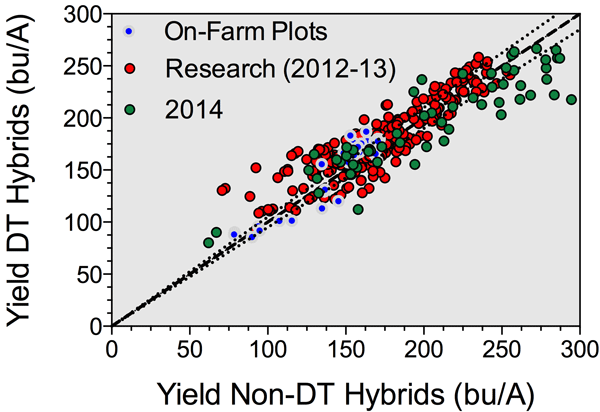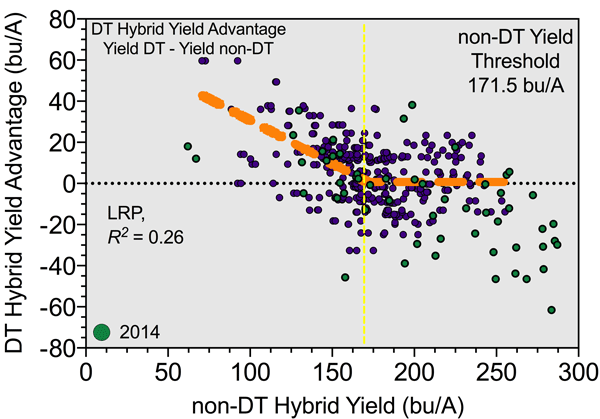Source: Kansas State University Research and Extension
In recent years, drought conditions have raised questions about the utilization of corn as the main crop for maximizing yield production per unit of available water in dryland environments.
Non-transgenic (conventionally bred, Pioneer and Syngenta) corn hybrids, or so-called “drought-tolerant” (DT) hybrids, came to the market with the expectation of increasing corn production in water-limited regions. In recent growing seasons, Monsanto also released its new biotech transgenic-DT hybrid.
Overall, the information from seed companies indicates that DT hybrids could provide from 2% to more than 15% yield increase over “competitor hybrids” in non-limiting and water-limiting environments, respectively.
Kansas State research conducted over the 2012-14 growing seasons across the state has recently been summarized. The objective of this research summary is to present an overview of the DT vs. non-DT responses to management practices such as plant population and irrigation.
The information below is intended to provide some guidance to farmers, consultants and agronomists in making the right decision for selecting corn hybrids. In addition, we hope to develop a better understanding of the kinds of environments in which DT hybrids could be most likely to result in a yield benefit. These hybrids are generally targeted for water-limited environments in the Western Great Plains.
Results
The research compared DT hybrids from diverse companies with a standard non-DT counterpart of similar maturity. The tests also evaluated the yield response to varying plant population and irrigation levels.
At the plant scale, our analysis did not reveal any change in the plant response to plant population between DT and non-DT hybrids. This indicates no need to change plant population when using DT hybrids.
The study also analyzed yields at the plot level for DT vs. comparable DT hybrids with similar maturity. The information presented in Figure 1 depicts the association of the yields for the DT vs. non-DT corn hybrids: Red points are research plots (2012-13); blue points are on-farm plots; and green points are 2014 growing season plots.
 |
| Figure 1. Yield for the DT vs. non-DT cron hybrids across several site-years for the 2012-14 growing seasons. |
Overall, the analysis found a yield benefit of 3% for DT vs. non-DT hybrids under diverse environments and stress conditions across Kansas during the 2012-14 seasons. In absolute terms, the yield advantage of using DT hybrids was around 5 bushels per acre compared to the non-DT material. Similar yield trends were observed in research plots and on-farm demonstration plots.
A great proportion of DT and non-DT yields were similar — within a 5% confidence interval as highlighted in Figure 1 — except in low-yielding and high-yielding environments. In low-yielding environments, DT out-yielded non-DT corn hybrids more often compared to the situation in higher-yield environments.
The analysis of information across diverse yielding environments gives a more clear understanding where there would be a yield advantage from planting DT hybrids. It is clear from Figure 2 that the yield advantage of DT corn hybrids increases as the yield potential of the crop decreases. This graph shows that there is basically no yield difference between DT and non-DT hybrids when yields are around 170 bushels per acre or greater. The yield advantage for DT hybrids gradually increases as the yield of the regular hybrids decreases from 170 bushels per acre.
It is important to note, however, that these are generalized relationships, and that there are varied responses at each yield level. Some individual points show no difference between DT vs. non-DT hybrids at yields around 100 bushels per acre. Other points show a 30-bushel-per-acre yield advantage for non-DT hybrids at 160-170 bushels per acre, and still others show a 60-bushel-per-acre yield advantage for DT hybrids when non-DT hybrid yields were near 70 bushels per acre.
On the opposite side of the yield environments, under high-yield environments (greater than 220 bushels per acre), individual points show a 30- to 60-bushel-per acre yield advantage for non-DT hybrids when DT hybrid yields were above 220 bushels per acre. How individual hybrids respond to a specific environment is influenced by a number of factors, including the timing and duration of the stress.
One more technical clarification is important to note. The linear response and plateau (LRP) function model fitted in Figure 2 (adjusted to the 2012-13 data), presented an R2 of 0.26 units, which can be interpreted to indicate that this model is accounting for only slightly more than a fourth of the total variation presented in the data. In other words, there are many management factors involved in the yield results, which makes it difficult to separate out the effect of hybrid alone.
 |
| Figure 2. Yield advantage for DT compared to non-DT corn hybrids at the same environment and population, ranging from low-yielding environments to high-yielding environments across several site-years for the 2012-14 growing seasons. |
Still, growers need to be cautious using and interpreting this information. More experiments and research data need to be collected, and a deeper understanding is needed to more properly comprehend the main causes of the yield differences of DT vs. non-DT corn genotypes. Potential interpretations offered for the yield advantage for the DT corn hybrids in certain environments are:
- Slower vegetative growth, saving water for reproductive stages (stress avoidance)
- Greater root biomass with superior water uptake
- Differential regulation in the stomata opening, controlling water and CO2 exchange processes
- Other potential physiological modifications
Summary
General observations:
1) Performance of individual hybrids within DT and non-DT types may vary. Some non-DT hybrids can perform nearly as well as the DT hybrids even in stressful conditions, and DT hybrids have the potential to yield with non-DT hybrids when water isn’t limiting.
2) The advantage of the DT hybrids became more evident when the water stress increased to the point of leaves rolling most days.
3) From the information at hand, it is reasonable to expect a DT hybrid to serve as a type of insurance policy to sustain yield potential under water-limited environments. It also appears that there is no yield penalty associated with DT hybrids if water-limiting conditions do not occur.
Lastly, it is critical to understand that these corn genetic materials will not produce yield if the environment is subjected to terminal drought. Growers cannot expect them to thrive when moisture is severely limited, especially in dryland systems. As properly and explicitly stated by all seed companies, these DT materials have demonstrated the ability to maintain yields to a certain degree in water-limited situations, and those differences will likely be in the order of 5-15 bushels per acre (depending on the environments and crop practices), when compared with a similar maturity non-DT corn hybrid.






Post a comment
Report Abusive Comment